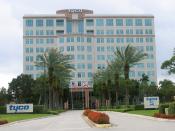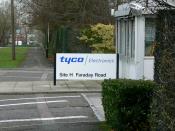This paper discusses the successful management planning of Tyco International Ltd. and the factors that influence the company's strategic, tactical, operational, and contingency planning. "Tyco is one of the leading suppliers of electronic components which include connectors and interconnect systems, relays, switches, circuit protection devices, touch screens and sensors as well as wires and cable." (Evening Times, Nov. 2007, p.2)Founded in 1960 when Arthur J. Rosenberg, opened a research laboratory to perform experimental work for the government. Rosenberg constituted the business as Tyco Laboratories in 1962. At this time the focus was changed to "high-tech materials science and energy conversion products for the commercial sector" (Tyco History, 2007). The company became publicly owned in 1964 and in 1965 Tyco began to acquire other companies to fill the gaps in the development and distribution networks. This resulted in Tyco's direction changing to manufacturing industrial products (Tyco History, 2007).
Tyco is the world's largest producer of goods and services in electrical and electronic components industries.
It is also the largest manufacturer, designer, installer and service provider of undersea telecommunications systems, fire protection systems, electronic security services, healthcare and specialty products, and flow control. According to (Tyco.com, 2000), as a result of these acquisitions, as well as strong growth of existing operations, Tyco today has a leading market share position in each of its business segments. It remains too committed to being the low-cost, high value producer in each of its manufacturing divisions, as well as world-class service provider to consumers around the world. "Tyco International is a diversified, global company that provides vital products and services to customers in more than 60 countries." (PR Newswire, Dec. 2007)From 1982-1986, Tyco International had developed market leadership by increasing profitability for its shareholders. According to (Tyco.com, 1982), Tyco organized its subsidiaries into three business segments...


